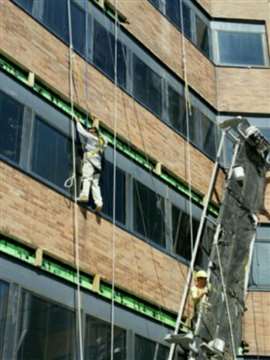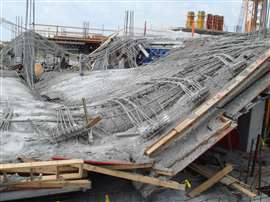Scaffold accident – or perhaps not
18 March 2024
Unfortunately, experience indicates that when the word scaffold is mentioned, it is immediately associated with the word accident.
The Merriam-Webster dictionary defines accident as “an unforeseen and unplanned event or circumstance.” It also defines it as an “unfortunate event resulting especially from carelessness or ignorance.” The dictionary also provides a legal themed definition, defining an accident as “an unexpected happening causing loss or injury which is not due to any fault or misconduct on the part of the person injured but for which legal relief may be sought.”
If we dare to combine the three definitions, one could argue that an accident is an unfortunate event, perhaps unexpected, which results in injury, and maybe even death, due to carelessness or ignorance, but is not the fault of the injured or dead person, who can be compensated with legal relief.
Or maybe a better definition would define an accident as something that happens where someone gets hurt because someone else did something carelessly or ignorantly, offering the injured person an opportunity to pursue legal action. If such is the case, then logically this would mean that if the injured person did something that caused the injury to himself/herself, then it would not be an accident.
 Figure 1. (Photo: David Glabe)
Figure 1. (Photo: David Glabe)
Suspended accidents
This relates to scaffolding, and other temporary structures such as shoring, in that these structures are used in ways that cause injuries, or even death.
As Figure 1 shows, a suspended scaffold – that is a scaffold platform supported by non-rigid means, such as a wire rope – fails and leaves the worker dangling. This is not healthy for the hanging individual and would imply that it is an accident. But what if the dangling worker caused the accident?
As previously defined, this would not be an accident since he caused the event that resulted in his injuries. Perhaps it is only an incident or event that resulted in injuries. But then again, perhaps not.
That brings us to the question of why scaffolding and accidents are assumed to be related. One explanation is that most people only know scaffolding from the information they receive from the internet, where scaffold events are prominently posted for all to see.
Safe erection, use and dismantling
Catching a suspended scaffold swinging in the wind because one of its ropes failed makes for great dramatic news. Better yet to get the worker dangling from her fall protection equipment, particularly when no rescue plan was established prior to the event. The longer she dangles, the better the story.
Interestingly, the vast majority of scaffolds are safely erected and used every day. But safe scaffolds do not make for good stories. Only chaos and mayhem sell the story because there is no excitement in a suspended scaffold on the side of a building, performing as expected, providing safe access to the face of the building for the workers.
Therefore, in the interest of providing ample resources for journalists, here is what is needed. Use faulty and damaged equipment. Do not provide training for the workers since adequate training would provide the workers with the knowledge to recognize hazards. We wouldn’t want that.
Since unauthorized workers like screwing with the rigging, do not conduct daily inspections despite the importance of inspections, especially for suspended scaffolds. Make sure you do not erect scaffolds under the supervision of a competent person, one who is capable of recognizing hazards and has the authorization to eliminate hazards; you wouldn’t want to ensure the scaffold will perform safely. And certainly, do not use trained erectors to install the rigging on a suspended scaffold. It’s much more news-worthy to have the rigging fail and leave the workers dangling.
And speaking of dangling, don’t bother with personal fall protection equipment. Let’s see how long the workers can hang on before falling to their deaths.
Training matters
Unfortunately, unsafe temporary structure usage isn’t limited to scaffolding. The shoring industry is no stranger to impressive collapses. Shoring, the equipment used to temporarily support structure loads such as concrete, is required to comply with regulations that are separate from scaffolding but address the same hazards.
While a collapsed shoring system will typically not result in dangling workers, it may cause the workers to experience serious injury and possibly death due to falls, or worse yet, being buried in the debris. Is the collapse an accident or not? Is the worker who was injured or killed the one who precipitated the collapse? If so, based on the above definition, it would appear an event occurred, not an accident. Does it matter? Probably not. What does matter is that the shoring collapsed.
 Figure 2. (Photo: David Glabe)
Figure 2. (Photo: David Glabe)
But why does shoring collapse? Experience confirms that somebody messed up. Either the designer produced a faulty design, or the workers did not install the shoring according to the design, they substituted equipment, or they used defective equipment. The collapsed shoring illustrated in Figure 2 was a result of substituted inferior equipment. Fortunately, no one was injured or killed.
Interestingly, accidents, I mean events or maybe incidents, are not a result of insufficient regulations and laws. There are plenty of those addressing all sorts of potential hazards. Rather, the root cause of the problem is training, or the lack thereof. Training reveals the limits of a worker’s knowledge. Think about it. Everybody does a task based on what they know.
Otherwise, they won’t do it. Only when we are told our limits do we know our limits. However, there is one caveat to that theory. In the temporary structure business, success breeds confidence, and too often, false confidence is based on false success.
For example, just because the suspended scaffold did not collapse does not necessarily mean the scaffold is safe for the reason that functionality disguises the failure point. That is, just because it worked is not an accurate measure of safety or knowledge.
On the other hand, training will tell you the level of knowledge workers have, and hopefully, that will tell workers their limitations.
STAY CONNECTED



Receive the information you need when you need it through our world-leading magazines, newsletters and daily briefings.
CONNECT WITH THE TEAM





